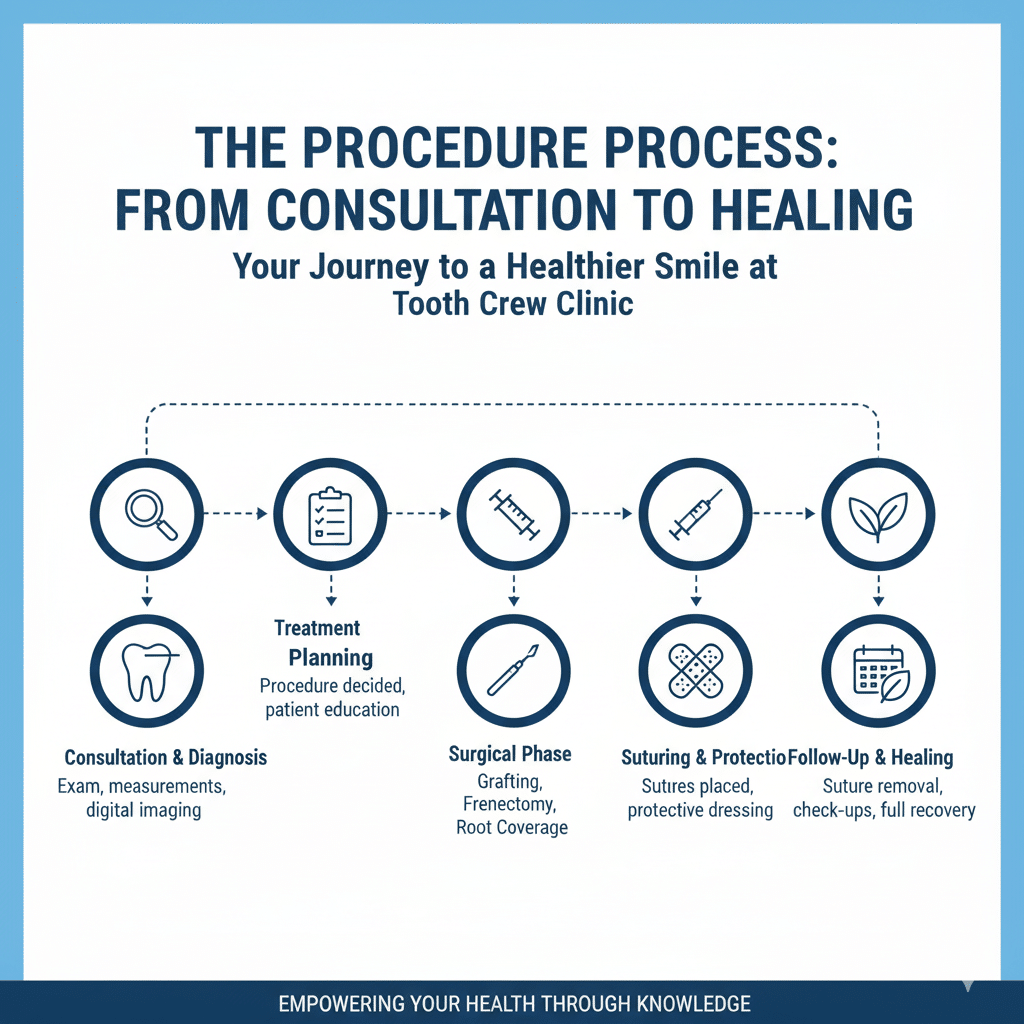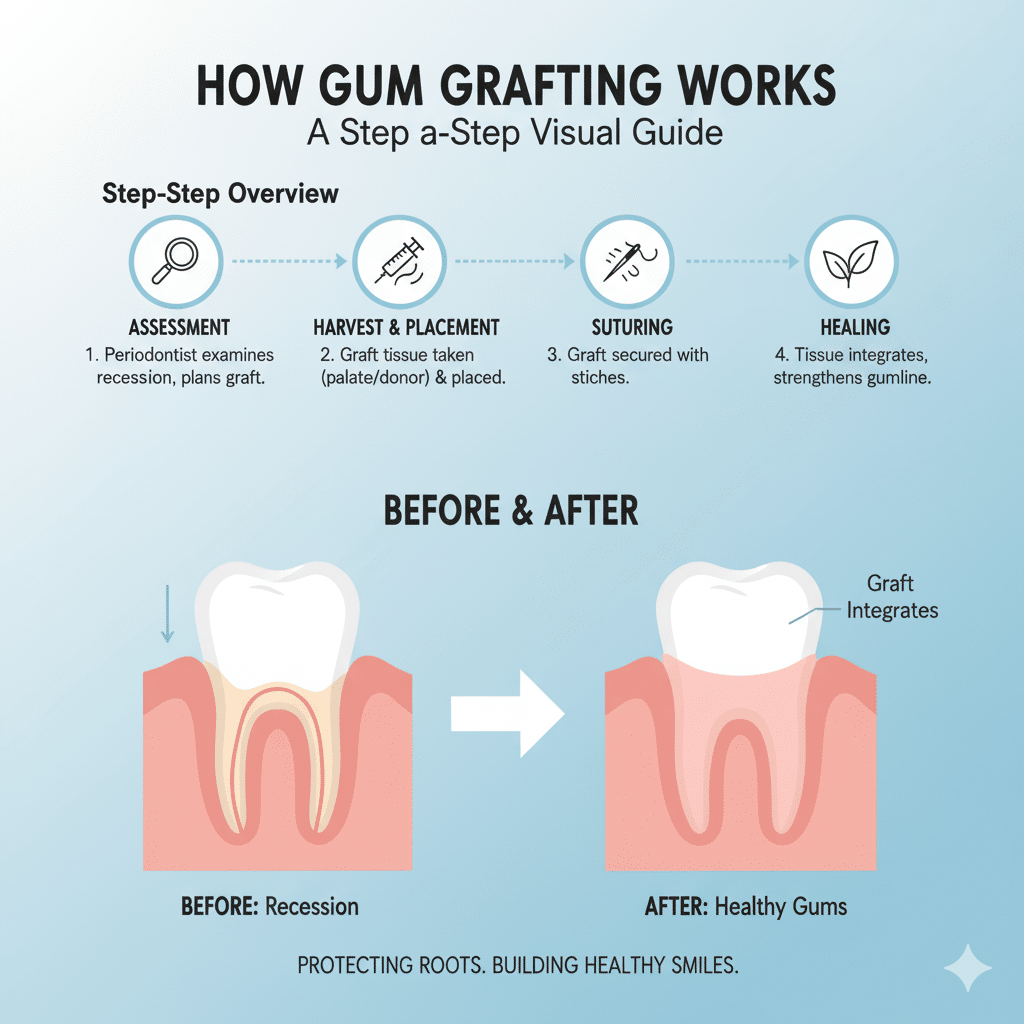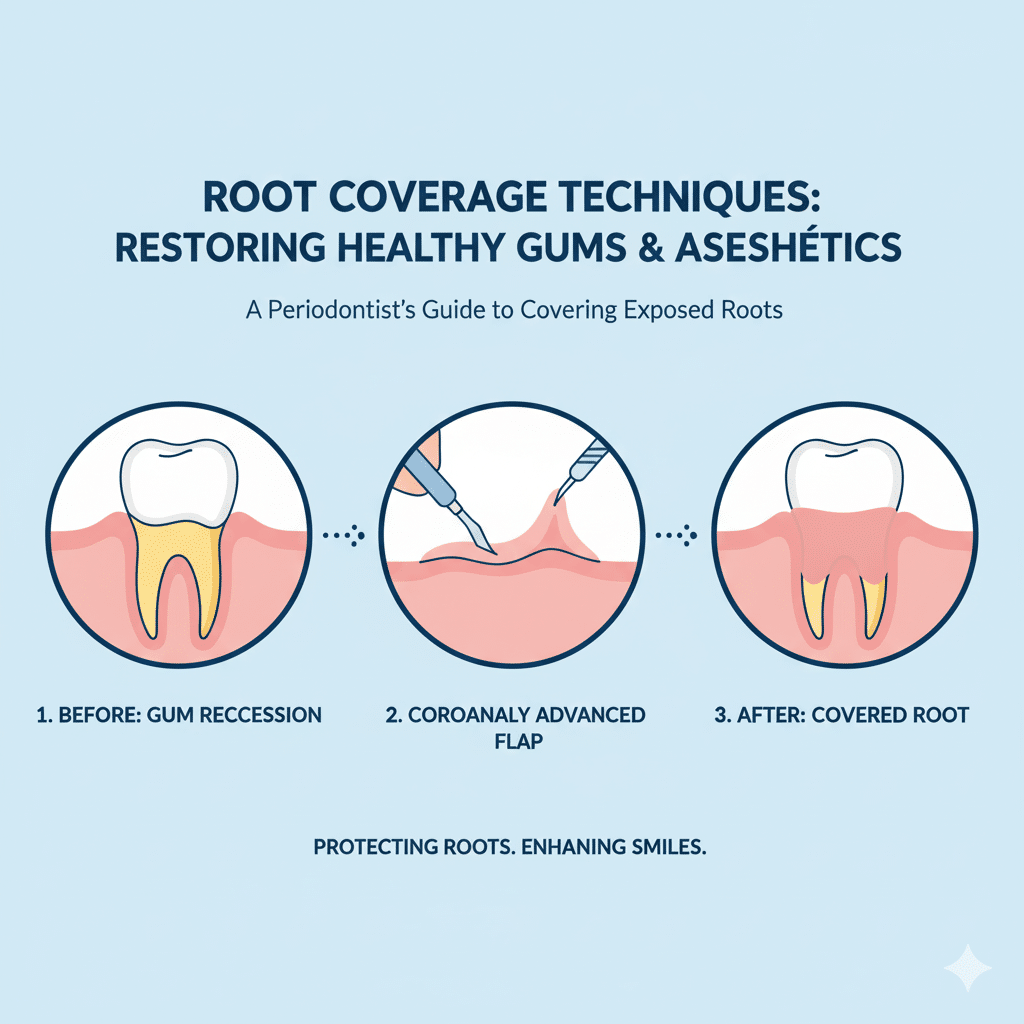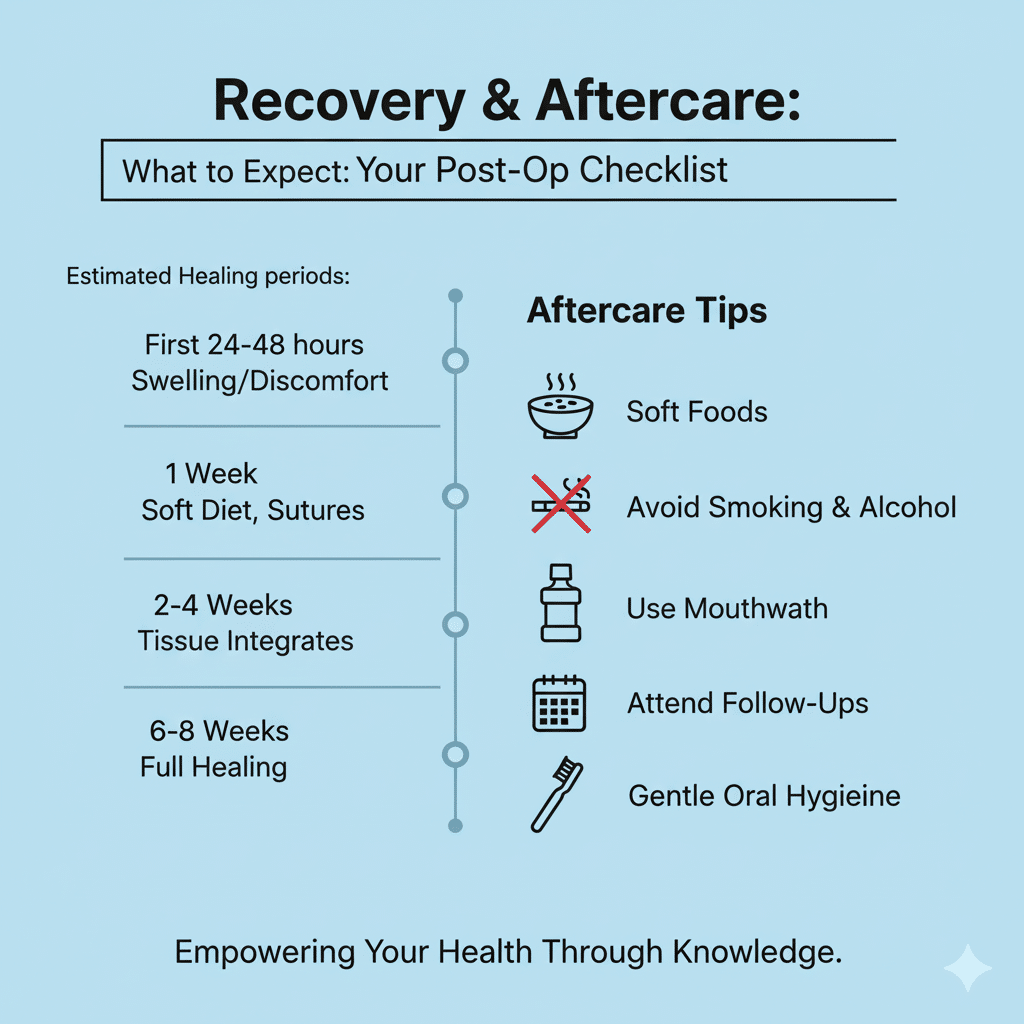Comprehensive Guide to Gum Grafting, Frenectomy, and Root Coverage
Introduction: Why Gums Matter as Much as Teeth
When most people think of oral health, the first thing that comes to mind is teeth—white, shiny, straight teeth. But dental specialists know that a truly healthy mouth depends on more than enamel. The gums form the foundation of every tooth. Without strong gum tissue, even the most well-cared-for teeth can loosen, decay, or fall out.
That’s why soft tissue surgeries, also called mucogingival surgeries, are among the most crucial treatments in periodontics. These procedures go beyond cosmetic fixes. They are designed to strengthen gums, cover exposed roots, correct structural problems, and prevent long-term complications.
At Tooth Crew Clinic Islamabad, our expert periodontists perform advanced gum surgeries tailored to each patient’s needs. This guide will cover in detail:
- Gum grafting (free gingival graft and connective tissue graft)
- Frenectomy and frenotomy
- Root coverage procedures for gum recession
Whether you’re worried about receding gums, facing sensitivity, or preparing for orthodontic or implant treatment, this article will answer every question you may have about soft tissue surgeries.
What Are Mucogingival Surgeries?
The term “mucogingival surgery” refers to periodontal procedures that correct the relationship between the gums, the teeth, and the surrounding bone. Unlike restorative dentistry (which focuses on repairing teeth) or prosthodontics (which replaces missing teeth), mucogingival surgery specifically addresses:
- Gum recession (pulling away from teeth)
- Insufficient gum thickness or strength
- Abnormal tissue attachments (frenum pulls)
- Loss of protective keratinized tissue
The goals of mucogingival surgery include:
- Improving gum tissue thickness and resilience
- Covering exposed roots for protection and aesthetics
- Enhancing support for teeth and implants
- Correcting functional issues that interfere with speech, chewing, or orthodontic stability
In short: while teeth are the stars of your smile, gum surgeries create the stage that keeps everything in place.
Gum Grafting – Rebuilding Lost Gum Tissue
Why Gum Grafts Are Needed
Gum recession is one of the most common oral health concerns. It develops slowly, often without pain, and many people don’t notice it until their teeth begin looking longer or they experience sharp sensitivity. The main causes include:
- Aggressive tooth brushing
- Periodontal (gum) disease
- Naturally thin gum biotype
- Misaligned teeth or orthodontic treatment
- Teeth grinding or clenching
- Aging
When gums recede, the tooth root becomes exposed. Roots are softer than enamel, which means they’re prone to cavities, wear, and painful sensitivity. Without intervention, recession may progress until the tooth loses support.
Types of Gum Grafts
Two of the most widely used grafting techniques are:
- Free Gingival Graft (FGG)
- Tissue is taken directly from the palate (roof of the mouth).
- Used when patients need to increase gum thickness and add keratinized tissue.
- Particularly beneficial for patients with very thin gums who are at risk of further recession.
- Connective Tissue Graft (CTG)
- Tissue is taken from beneath the surface of the palate, not the outer layer.
- Provides excellent cosmetic outcomes because it blends naturally with existing gums.
- Ideal for covering exposed roots in the front teeth where aesthetics are important.
Comparison Table:
| Feature | Free Gingival Graft (FGG) | Connective Tissue Graft (CTG) |
| Donor site | Surface of palate | Beneath palate tissue |
| Goal | Increase thickness | Cover exposed roots |
| Best for | Thin gums, prevention | Aesthetic areas, sensitivity relief |
| Healing | Slightly longer | Faster, more comfortable |
How Gum Grafting Works (Step-by-Step)
- Assessment: The periodontist examines gum recession, measures thickness, and identifies the best graft type.
- Anesthesia: Local anesthesia ensures the procedure is painless.
- Tissue Harvesting: The graft is taken from the palate (or a donor source if necessary).
- Placement: The graft is sutured over the recession area.
- Healing: Over several weeks, the graft integrates with surrounding tissue, creating a stronger gumline.
Frenectomy & Frenotomy – Small Tissues, Big Impact
Understanding the Frenum
The frenum is a band of tissue that connects the lips, cheeks, or tongue to the gums. Most people have no issues with it, but when the frenum is too short, tight, or thick, it creates problems such as:
- Gaps between teeth (usually upper front teeth)
- Pulling on gums, causing recession
- Difficulty with orthodontic closure of spaces
- Tongue-tie in children (restricts tongue movement, affecting speech and feeding)
Frenectomy vs. Frenotomy
- Frenotomy: Involves a small incision to loosen the frenum.
- Frenectomy: Involves complete removal of the frenum.
Both can be performed with traditional surgical methods or laser-assisted dentistry, which reduces bleeding, minimizes discomfort, and speeds healing.
Benefits of Frenum Surgery
- Prevents gum recession caused by tissue pulling
- Allows orthodontic treatment to close diastemas (gaps) successfully
- Improves oral hygiene by eliminating areas of tension
- Enhances tongue mobility in children and adults
Case highlight: At Tooth Crew Clinic Islamabad, a 12-year-old patient underwent a laser frenectomy to release a frenum pull between her front teeth. This simple procedure enabled her orthodontic braces to close the gap permanently.
Root Coverage Procedures – Protecting Exposed Roots
Why Root Coverage Is Important
When gums recede, teeth don’t just look unattractive—they become vulnerable. Roots are not protected by enamel, meaning:
- They wear away quickly under brushing pressure
- They develop cavities easily
- They cause sensitivity to temperature changes
- They weaken tooth stability
Root Coverage Techniques
Periodontists use several methods to cover roots:
- Coronally Advanced Flap (CAF): Gum tissue near the recession is lifted and repositioned over the exposed root.
- Tunnel Technique with Grafting: A minimally invasive method where a tunnel is created under the gumline, and graft tissue is inserted to cover the root.
- Combination with Connective Tissue Graft: Ensures both coverage and long-term stability.
These techniques restore not only the function of gums but also aesthetics—especially vital in the smile zone.
The Procedure Process: From Consultation to Healing
One of the most common questions patients ask is: “What exactly happens during these surgeries?” At Tooth Crew Clinic Islamabad, we believe that informed patients feel more confident and recover faster. Here’s what to expect:
1. Initial Consultation & Diagnosis
- A comprehensive gum examination is carried out using periodontal probes and digital imaging.
- Measurements are taken to assess gum thickness, pocket depth, and the extent of recession.
- In some cases, digital smile design software is used to predict the outcome.
2. Treatment Planning
- The periodontist decides whether a gum graft, frenectomy, or root coverage is needed—or sometimes a combination.
- For complex cases, such as multiple areas of recession, a staged approach may be planned.
- Patients are educated about the procedure, risks, costs, and expected results.
3. Anesthesia
- Local anesthesia ensures that the entire procedure is painless.
- For anxious patients, sedation dentistry may also be offered.
4. Surgical Phase
- Gum Grafting: Donor tissue is harvested (commonly from the palate) and sutured to the recipient site.
- Frenectomy: Either laser or scalpel is used to release/remove the frenum.
- Root Coverage: Gum tissue is gently mobilized and repositioned, sometimes with added graft tissue.
5. Suturing and Protection
- Delicate sutures secure the tissue in place.
- In some cases, a periodontal dressing (healing bandage) is placed to protect the surgical site.
6. Follow-Up Appointments
- Typically, the first check-up is after 7–10 days for suture removal.
- Further follow-ups at 3–6 weeks ensure integration of the graft and stabilization of the gumline.

Benefits of Soft Tissue Surgeries
These procedures are not just about “fixing gums.” Their benefits are broad and long-lasting.
1. Medical Benefits
- Protect exposed roots from cavities and wear.
- Reduce sensitivity to cold, hot, and sweet foods.
- Prevent further gum recession and eventual tooth loss.
2. Functional Benefits
- Strengthen weak gum tissue, providing better tooth stability.
- Improve the long-term success of dental implants and orthodontic treatments.
- Correct tongue-tie or lip-tie issues, improving speech and chewing.
3. Cosmetic Benefits
- Create a balanced gumline that complements the smile.
- Eliminate the appearance of “long teeth.”
- Close unsightly gaps caused by frenum pulls.
4. Preventive Benefits
- Stop gum disease from progressing into deeper periodontal problems.
- Reduce future treatment costs by addressing issues early.
Risks and Possible Complications
Any surgical procedure carries some risks, though complications are rare when performed by experienced periodontists. Potential issues include:
- Temporary swelling and mild discomfort.
- Bleeding at the surgical or donor site.
- Palatal soreness (in gum grafting).
- Incomplete graft integration (rare).
- Need for touch-up procedures in complex cases.
At Tooth Crew Clinic, our use of laser dentistry, precision microsurgical techniques, and sterile environments keeps risks to an absolute minimum.
Cost of Soft Tissue Surgeries
Many patients worry about affordability. The good news is that in Islamabad, costs are much lower than in Western countries while maintaining international standards of care.
| Procedure | Average Cost in Islamabad (PKR) | Cost in USA (USD) | Cost in UK (GBP) |
| Gum Grafting | 30,000 – 60,000 | $1,000 – $3,000 | £900 – £2,500 |
| Frenectomy/Frenotomy | 15,000 – 30,000 | $400 – $1,200 | £350 – £900 |
| Root Coverage Surgery | 35,000 – 70,000 | $1,200 – $3,500 | £1,000 – £2,800 |
👉 This makes Tooth Crew Clinic Islamabad a cost-effective choice for patients seeking high-quality periodontal care at a fraction of global prices.
Recovery & Aftercare: What to Expect
Healing from soft tissue surgeries is usually smooth, provided you follow your dentist’s instructions.
Recovery Timeline
- First 24–48 hours: Mild swelling and discomfort, managed with painkillers and cold compress.
- 1 week: Sutures remain in place; soft diet is recommended.
- 2–4 weeks: Gum tissue begins integrating with surrounding tissue.
- 6–8 weeks: Full healing and stability achieved.
Aftercare Tips
- Stick to soft foods (soups, yogurt, eggs, smoothies) for the first week.
- Avoid brushing directly on the surgical site until advised.
- Use prescribed antimicrobial mouthwash to reduce infection risk.
- Refrain from smoking and alcohol, as they delay healing.
- Attend all follow-up appointments to ensure proper recovery.
Frequently Asked Questions (FAQs)
- Is gum grafting painful?
No. The surgery is done under anesthesia, and most patients describe recovery as mild soreness, not severe pain. - Can gums grow back naturally?
No. Once gum tissue is lost, it cannot regenerate on its own—surgery is required. - How long do the results last?
With proper oral hygiene and regular dental check-ups, results are long-lasting, often permanent. - Are there alternatives to gum grafts?
Mild gum recession may be managed with lifestyle changes, but surgical intervention is the only predictable way to restore tissue. - Will it affect my ability to talk or eat?
Temporary adjustments may be needed, but within days most patients return to normal routines.
Why Choose Tooth Crew Clinic Islamabad?
- Expert Periodontists: Specialists trained in advanced soft tissue techniques.
- Laser-Assisted Surgery: Less pain, less bleeding, faster healing.
- Patient-Centered Care: Every treatment is tailored to your condition and goals.
- Affordable Excellence: International-level expertise at local costs.
- Trusted Reputation: Our clinic is a leading choice for periodontal surgery in Islamabad.
Conclusion: Protecting Your Smile’s Foundation
Soft tissue and mucogingival surgeries—gum grafting, frenectomy, and root coverage—are more than cosmetic fixes. They are crucial for preserving the health, function, and longevity of your teeth. By strengthening gums and protecting roots, these procedures ensure your smile remains beautiful and your teeth stay strong for life.
At Tooth Crew Clinic Islamabad, we combine science, technology, and compassion to deliver the highest quality periodontal care. If you are experiencing gum recession, sensitivity, or structural gum issues, don’t wait for the problem to worsen.
📞 Book your consultation today at Tooth Crew Clinic and take the first step toward healthier gums and a confident smile.




